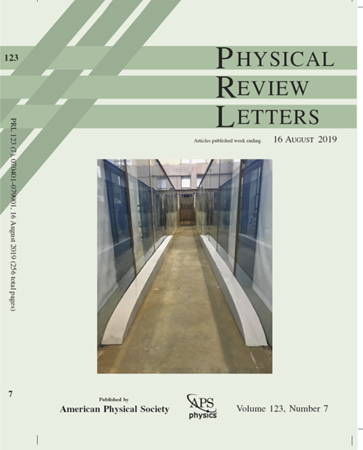观测阈值以上电离的阿秒级时间延迟
IF 8.1
1区 物理与天体物理
Q1 PHYSICS, MULTIDISCIPLINARY
引用次数: 0
摘要
要了解光与物质如何在最基本的层面上相互作用,就必须对光电离进行阿秒级的时间特征描述。然而,对阈值以上强场电离的时间特性进行表征仍是一个未知数。在这里,我们提出了一种新颖的光电子干涉测量方法,用于将库仑效应的贡献从attoclock中分离出来,使我们能够对阈值以上强场电离的能量分辨时间延迟进行计时。我们区分了attoclock的两种库仑效应,一种是单个电子轨迹的库仑扰动效应,另一种是库仑场导致的光电子相空间畸变效应。我们发现,第二种库仑效应表现为电子发射的能量分辨阿秒时间延迟,这与隧道出口处的非绝热初始纵向动量效应有关。我们的研究进一步表明,时间延迟对一个半激光周期内释放的电子波包的时间轮廓非常敏感。我们发现释放的电子波包的时间宽度随能量的增加而增加,这与绝热图中的常见假设相矛盾。本文章由计算机程序翻译,如有差异,请以英文原文为准。
Observation of Attosecond Time Delays in Above-Threshold Ionization
Attosecond-scale temporal characterization of photoionization is essential in understanding how light and matter interact on the most fundamental level. However, characterizing the temporal property of strong-field above-threshold ionization has remained unreached. Here, we propose a novel photoelectron interferometric method to disentangle the contribution of Coulomb effect from an attoclock, allowing us to clock energy-resolved time delays of strong-field above-threshold ionization. We disentangle two types of Coulomb effects for the attoclock, i.e., one arising from the Coulomb disturbance of a single electron trajectory and the second effect arising from the photoelectron phase space distortion due to the Coulomb field. We find that the second Coulomb effect manifests itself as an energy-resolved attosecond time delay in the electron emission, which is relevant to the effect of nonadiabatic initial longitudinal momentum at the tunnel exit. Our study further indicates a sensitivity of the time delay to the temporal profile of the released electron wave packet within one half laser cycle. The temporal width of the released electron wave packet is found to increase with energy, which contradicts the common assumption in the adiabatic picture.
求助全文
通过发布文献求助,成功后即可免费获取论文全文。
去求助
来源期刊

Physical review letters
物理-物理:综合
CiteScore
16.50
自引率
7.00%
发文量
2673
审稿时长
2.2 months
期刊介绍:
Physical review letters(PRL)covers the full range of applied, fundamental, and interdisciplinary physics research topics:
General physics, including statistical and quantum mechanics and quantum information
Gravitation, astrophysics, and cosmology
Elementary particles and fields
Nuclear physics
Atomic, molecular, and optical physics
Nonlinear dynamics, fluid dynamics, and classical optics
Plasma and beam physics
Condensed matter and materials physics
Polymers, soft matter, biological, climate and interdisciplinary physics, including networks
 求助内容:
求助内容: 应助结果提醒方式:
应助结果提醒方式:


